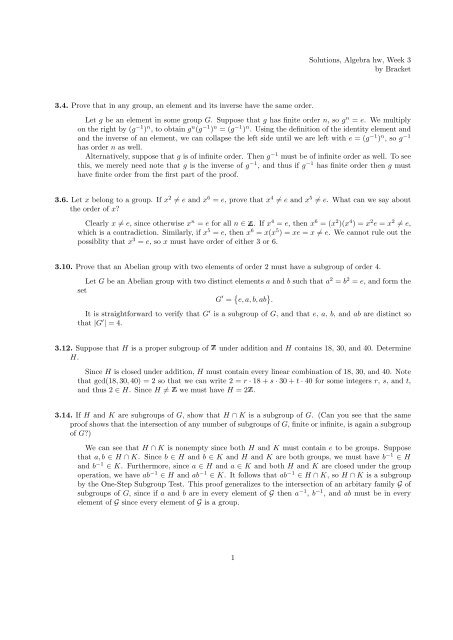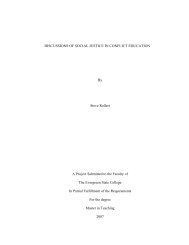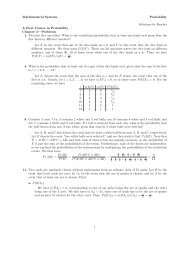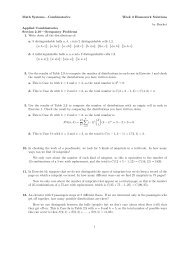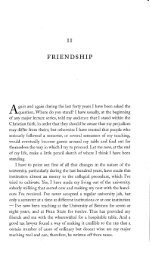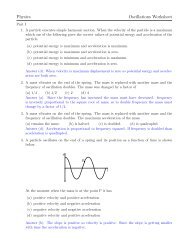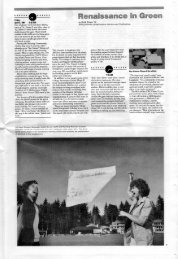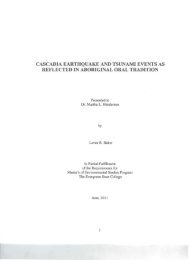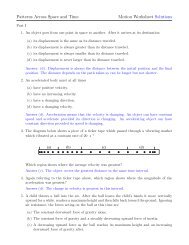Solutions, Algebra hw, Week 3 by Bracket 3.4. Prove that ... - Archives
Solutions, Algebra hw, Week 3 by Bracket 3.4. Prove that ... - Archives
Solutions, Algebra hw, Week 3 by Bracket 3.4. Prove that ... - Archives
You also want an ePaper? Increase the reach of your titles
YUMPU automatically turns print PDFs into web optimized ePapers that Google loves.
<strong>3.4.</strong> <strong>Prove</strong> <strong>that</strong> in any group, an element and its inverse have the same order.<br />
<strong>Solutions</strong>, <strong>Algebra</strong> <strong>hw</strong>, <strong>Week</strong> 3<br />
<strong>by</strong> <strong>Bracket</strong><br />
Let g be an element in some group G. Suppose <strong>that</strong> g has finite order n, so g n = e. We multiply<br />
on the right <strong>by</strong> (g −1 ) n , to obtain g n (g −1 ) n = (g −1 ) n . Using the definition of the identity element and<br />
and the inverse of an element, we can collapse the left side until we are left with e = (g −1 ) n , so g −1<br />
has order n as well.<br />
Alternatively, suppose <strong>that</strong> g is of infinite order. Then g −1 must be of infinite order as well. To see<br />
this, we merely need note <strong>that</strong> g is the inverse of g −1 , and thus if g −1 has finite order then g must<br />
have finite order from the first part of the proof.<br />
3.6. Let x belong to a group. If x 2 = e and x 6 = e, prove <strong>that</strong> x 4 = e and x 5 = e. What can we say about<br />
the order of x?<br />
Clearly x = e, since otherwise x n = e for all n ∈ . If x 4 = e, then x 6 = (x 2 )(x 4 ) = x 2 e = x 2 = e,<br />
which is a contradiction. Similarly, if x 5 = e, then x 6 = x(x 5 ) = xe = x = e. We cannot rule out the<br />
possiblity <strong>that</strong> x 3 = e, so x must have order of either 3 or 6.<br />
3.10. <strong>Prove</strong> <strong>that</strong> an Abelian group with two elements of order 2 must have a subgroup of order 4.<br />
Let G be an Abelian group with two distinct elements a and b such <strong>that</strong> a 2 = b 2 = e, and form the<br />
set<br />
G ′ = e, a, b, ab .<br />
It is straightforward to verify <strong>that</strong> G ′ is a subgroup of G, and <strong>that</strong> e, a, b, and ab are distinct so<br />
<strong>that</strong> |G ′ | = 4.<br />
3.12. Suppose <strong>that</strong> H is a proper subgroup of under addition and H contains 18, 30, and 40. Determine<br />
H.<br />
Since H is closed under addition, H must contain every linear combination of 18, 30, and 40. Note<br />
<strong>that</strong> gcd(18, 30, 40) = 2 so <strong>that</strong> we can write 2 = r · 18 + s · 30 + t · 40 for some integers r, s, and t,<br />
and thus 2 ∈ H. Since H = we must have H = 2.<br />
3.14. If H and K are subgroups of G, show <strong>that</strong> H ∩ K is a subgroup of G. (Can you see <strong>that</strong> the same<br />
proof shows <strong>that</strong> the intersection of any number of subgroups of G, finite or infinite, is again a subgroup<br />
of G?)<br />
We can see <strong>that</strong> H ∩ K is nonempty since both H and K must contain e to be groups. Suppose<br />
<strong>that</strong> a, b ∈ H ∩ K. Since b ∈ H and b ∈ K and H and K are both groups, we must have b −1 ∈ H<br />
and b −1 ∈ K. Furthermore, since a ∈ H and a ∈ K and both H and K are closed under the group<br />
operation, we have ab −1 ∈ H and ab −1 ∈ K. It follows <strong>that</strong> ab −1 ∈ H ∩ K, so H ∩ K is a subgroup<br />
<strong>by</strong> the One-Step Subgroup Test. This proof generalizes to the intersection of an arbitary family G of<br />
subgroups of G, since if a and b are in every element of G then a −1 , b −1 , and ab must be in every<br />
element of G since every element of G is a group.<br />
1
3.20. If H is a subgroup of G, then <strong>by</strong> the centralizer C(H) of H we mean the set<br />
C(H) = x ∈ G xh = hx for all h ∈ H .<br />
<strong>Prove</strong> <strong>that</strong> C(H) is a subgroup of G.<br />
Note <strong>that</strong> x ∈ C(H) iff hxh−1 = x for all h ∈ H. Clearly, heh−1 = hh−1 = e, so e ∈ C(H).<br />
Suppose <strong>that</strong> a, b ∈ C(H). Then for any h ∈ H, we have hbh−1 = b. Taking the inverse, we obtain<br />
b−1 = (hbh−1 ) −1 = hb−1h−1 . Furthermore, we have a = hah−1 , so ab−1 = (hah−1 )(hb−1h−1 ) =<br />
h(aeb−1 )h−1 = h(ab−1 )h−1 . Thus ab−1 ∈ C(H), and it follows <strong>that</strong> C(H) is a subgroup of G from<br />
the One-Step Subgroup Test.<br />
Alternatively, we can see <strong>that</strong> C(H) = <br />
h∈H C(h), and we can apply Problem 3.14 to see <strong>that</strong> this<br />
intersection is a group.<br />
3.27. Suppose a group contains elements a and b such <strong>that</strong> |a| = 4, |b| = 2, and a 3 b = ba. Find |ab|.<br />
Since |a| = 4 and |b| = 2, we have a 4 = e and b 2 = e.We then multiply ba = a 3 b on the left <strong>by</strong> a<br />
and on the right <strong>by</strong> b to obtain abab = (ab)(ab) = a 4 b 2 = ee = e. Note <strong>that</strong> ab = e, since <strong>that</strong> would<br />
mean b is the inverse of a, and Problem 3.4 would guarantee <strong>that</strong> a and b have the same order. Thus,<br />
(ab) 2 = e and (ab) n = e for any smaller positive integer power n, so |ab| = 2.<br />
3.31. Let G be the symmetry group of a circle. Show <strong>that</strong> G has elements of every finite order as well as<br />
elements of infinite order.<br />
For any positive integer n, the element R 360/n must have order n. If we choose any irrational<br />
number x such <strong>that</strong> 0 < x < 360, then Rx is of infinite order.<br />
2


